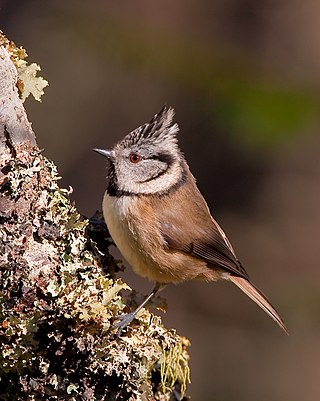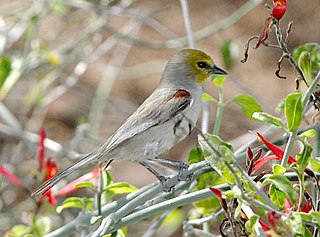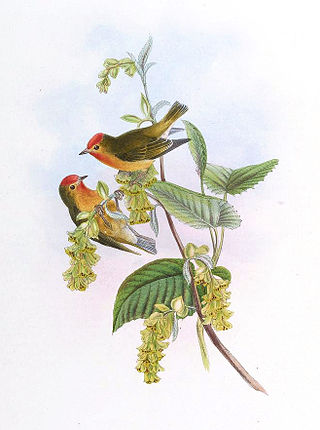
The bushtits or long-tailed tits are small passerine birds from the family Aegithalidae, containing 13 species in three genera, all but one of which (Psaltriparus) are found in Eurasia. Bushtits are active birds with long tails compared to their size, moving almost constantly while they forage for insects in shrubs and trees. During non-breeding season, birds live in flocks of up to 50 individuals. Several bushtit species display cooperative breeding behavior, also called helpers at the nest.

The tits, chickadees, and titmice constitute the Paridae, a large family of small passerine birds which occur mainly in the Northern Hemisphere and Africa. Most were formerly classified in the genus Parus.

The verdin is a species of penduline tit. It is the only species in the genus Auriparus and the only representative of the old world family Remizidae to be found in North America.

Passerida is, under the Sibley-Ahlquist taxonomy, one of two parvorders contained within the suborder Passeri. While more recent research suggests that its sister parvorder, Corvida, is not a monophyletic grouping, the Passerida as a distinct clade are widely accepted.

The sultan tit is an Asian forest bird with a yellow crest, dark bill, black upperparts plumage and yellow underparts. The sexes are similar. The female has greenish-black upperparts and a yellowish throat. The young bird is duller than the adult and has a shorter crest. It is the only member of the monotypic genus Melanochlora, which is fairly distinct from the Parus tits with the nearest relative being the monotypic Sylviparus.

The Eurasian penduline tit or European penduline tit is a passerine bird of the genus Remiz. It is relatively widespread throughout the western Palearctic. It is migratory in the northern part of its range but resident in the southern part.

The grey penduline tit, also known as the African penduline-tit, is a species of bird in the family Remizidae. It is found in Angola, Botswana, Burundi, Republic of the Congo, Democratic Republic of the Congo, Eswatini, Kenya, Malawi, Mozambique, Namibia, Rwanda, South Africa, Tanzania, Uganda, Zambia, and Zimbabwe. Its natural habitats are subtropical or tropical dry forests, dry savanna, and moist savanna. At 8 to 9 cm in length and a weight of 6.5 g (0.23 oz), it is one of the smallest species of bird found in Africa, along with its cousin the Cape penduline tit and the perhaps smaller mouse-colored penduline tit and the tit hylia.

Anthoscopus is a genus of birds in the penduline tit family Remizidae. The genus is restricted to Sub-Saharan Africa, where it ranges from the Sahel to South Africa. Unlike many of the Eurasian penduline, these species are not generally migratory, instead remaining close to their breeding sites year round. A wide range of habitats is occupied by the six species, from deserts to woodlands to rainforest.

The Cape penduline tit or southern penduline tit is a species of bird in the family Remizidae. It is found in Angola, Botswana, Namibia, South Africa, and Zimbabwe. Its natural habitats are dry savannah, subtropical or tropical dry shrubland, and Mediterranean-type shrubby vegetation. At eight centimetres (3 in) in length, it is one of the smallest species of bird found in Africa, along with its cousins the grey penduline tit and the mouse-coloured penduline tit.

The mouse-coloured penduline tit or mouse-colored penduline tit is a species of bird in the family Remizidae. At 8 cm (3.1 in) in length, it is one of the two shortest birds native to Africa, alongside the tit hylia.

Yellow penduline tit is a species of bird in the family Remizidae. This small yellow passerine bird is found in semi-arid savanna regions of West Africa.

The fire-capped tit is a small, 10 cm (3.9 in) long, weighing about 7 g (0.25 oz) bird species assigned to the family Paridae, that breeds in the temperate forest bordering the Himalayas to the south, in the Hengduan Shan and Nujiang Shan on the Myanmar-China border, the Micah Shan and Daba Shan on the Northern Sichuan border. It winters down hill and further south. Further to the east, birds tend to be smaller and the plumage becomes gradually darker.

The Chinese penduline tit is a species of bird in the family Remizidae. The species was first described by Robert Swinhoe in 1870. It is found in China, Japan, North Korea, South Korea, and Russia. There are 10 species in the family Remizidae. They are similar to true tits, but make characteristic penduline nests. They inhabit open fields and wetlands. They have sharp bill tips and the sexes look alike.

Remiz is a genus of birds in the family Remizidae, commonly known as the Eurasian pendulines. Like other penduline tits, they are named for their elegant, pendulous nests.

The white-crowned penduline tit is a species of bird in the family Remizidae. It is found in Afghanistan, China, India, Kazakhstan, Mongolia, Pakistan, Russia, and Tajikistan.

The black-headed penduline tit is a species of bird in the family Remizidae. It is found in Central Asia in reed beds along lakes or rivers. Its distribution is fragmented. It is the least thoroughly-documented bird in the Remiz genus, and has been described as one of the most poorly-known bird in Central Asia.

Hyliidae is a family of passerine birds which contains just two species, the green hylia and the tit hylia. Physiological similarities and molecular phylogenetic studies strongly support the creation of this family.

The Paroidea are a superfamily of passerine birds.






















